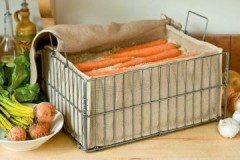Terms and rules for harvesting carrots for storage for the winter
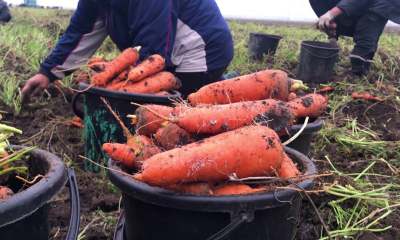 Not a single kitchen in the world can do without juicy, sweet carrots. But it is not enough to grow a rich harvest, it is very important to harvest it on time and correctly.
Not a single kitchen in the world can do without juicy, sweet carrots. But it is not enough to grow a rich harvest, it is very important to harvest it on time and correctly.
Lack of knowledge can nullify all efforts to grow this juicy, tasty and very healthy root vegetable.
When and how to properly remove carrots from the garden, are there any nuances of harvesting root crops for storage for the winter, we will consider in the article.
Content
When do you need to remove from the garden?
Several factors influence the selection of the most suitable harvest period for carrots.
Variety
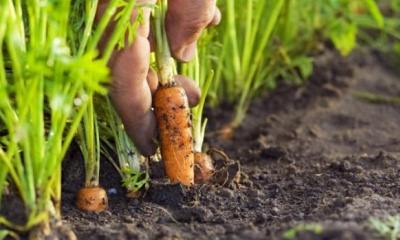 Picking up the harvest period for carrots, it is very important to take into account the variety of the root crop and the timing of its ripening (indicated by the seed manufacturer on the package).
Picking up the harvest period for carrots, it is very important to take into account the variety of the root crop and the timing of its ripening (indicated by the seed manufacturer on the package).
So early varieties are fully ripe by mid-June. Two to three months after the germination of the seeds, the root crop gains a maximum of useful substances, becomes juicy and sweet.
It is very important not to miss the collection time early varieties of carrots, otherwise it loses:
- taste,
- juiciness,
- nutrients.
Harvesting mid-season varieties begins in late August - early September. Three to four months after the seeds germinate, the root vegetable gains the maximum amount of vitamins and sweetness.
Ideal varieties of carrots for long winter storage are late. The harvest season starts in the last days of September. The vegetable accumulates the maximum amount of nutrients, juiciness and sweet taste in four to five months after seed germination.
The best varieties for long-term storage:
- Emperor (characterized by dense, sweet orange-red flesh);
- Samson (large fruits weighing up to 200g, bright orange);
- Canada (late variety has a high yield).
Climatic growing conditions
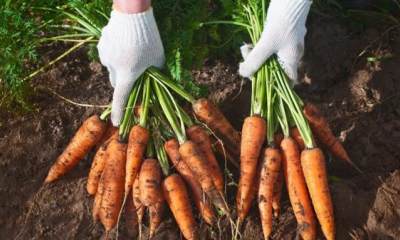 One of the main criteria for choosing the time to harvest carrots is the growing region with its climatic features.
One of the main criteria for choosing the time to harvest carrots is the growing region with its climatic features.
So in central Russia (including in the Moscow region), they begin to dig vegetables from the second half of September... Often, the first weeks of autumn in this region are rainy, so you should not rush to harvest, calmly waiting for stable, dry weather.
At the same time, it must be remembered that a very early harvest can lead to the fact that the harvested carrots turn out to be tasteless, slightly bitter (the root crop simply does not have time to collect the required amount of sugar and nutrients).
Harvesting in the Urals is determined by the sowing time... Most often, early and mid-ripening varieties are sown, which in a relatively short summer have time to fully ripen, gain the required amount of vitamins. Already in the first week of August, carrots are tested for readiness for digging.
If the summer is rainy and cold, then the harvest time is postponed by ten to fifteen days.
In the harsh climatic conditions of Siberia, adapted varieties are chosen for cultivation with a growing season of no more than one hundred days. Harvesting begins three months after the appearance of the first shoots (approximately in the last week of August, early September).
Weather
The optimal harvesting period occurs when the outside air temperature is kept within the range from + 5 ° C to + 8 ° C. It is at this time that carrots, filled with sweetness, juiciness and nutrients as much as possible, stop their growth.
 You should not rush to collect carrots, as you can be disappointed with the taste of the grown root crop.
You should not rush to collect carrots, as you can be disappointed with the taste of the grown root crop.
It is necessary to harvest before the first frost.... Already at -3 ° C, gray rot may appear on carrots, which can completely destroy the crop.
Vegetables are harvested only in dry, slightly cloudy weather (rain and heat negatively affect the quality of the harvested crop).
State of tops and soil
A sure sign that the carrot is ripe is dry, yellowed lower leaves... Having noticed them, it is necessary to immediately start harvesting, since the further presence of carrots in the ground can cause the vegetable to crack, outgrow, and lose its juiciness and taste.
It is necessary to dig up carrots without waiting for the soil to freeze. The root crop should easily come out of the soil by twisting or using a pitchfork.
How to collect correctly?
Adhering to a clear algorithm of actions, you can quickly harvest carrots:
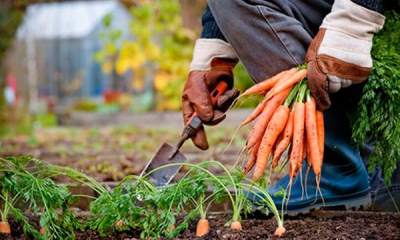 Thirty days before the expected date of harvesting, watering of the beds is stopped (roots are dug only from dry soil).
Thirty days before the expected date of harvesting, watering of the beds is stopped (roots are dug only from dry soil).- The short carrots grown on sandy loose soils are harvested by hand. To do this, they rest against the ground with one hand, and with the other, grasping the tops, pull out the carrot.
- A long root crop is dug with a pitchfork (it is not recommended to use a shovel, so as not to damage the delicate skin).
To do this, the pitchfork is inserted into the ground at a distance of 8 cm from the carrot, and gently pressing on the handle, undermine the vegetable. The earthen ball is lifted together with the carrot, after which the root crop is pulled from the ground by the tops.
It is convenient to harvest carrots in pairs. One is digging in a vegetable with a pitchfork, the second person pulls the carrot by the tops.
Do I need to dry?
To prepare the harvested crop of carrots for long-term storage, it is necessary to carry out a number of activities:
- Clean root vegetables from dirt. Clods of earth are cleaned by hand. A knife or any other sharp metal objects injure the skin of the carrot, which significantly reduces the storage time of vegetables.
- Sort the harvested crop. At the same time, peeling the carrots from the ground, the roots are sorted. First of all, vegetables with damage, cracks, signs of spoilage are separated (such carrots are processed). For long-term storage, large, dense, undamaged fruits are laid. Small carrots are laid separately. It is eaten in the first place.
- With a sharp, clean knife, trim the tops, or separate the greens from the root crops by hand using the twisting method.
- Dry the carrots, leaving the vegetables in the garden for two hours.
- Before laying carrots for long-term storage, vegetables must be kept for five hours in a dark, well-ventilated place. During this time, the carrots are cooled, which allows them to take on a fairly low air temperature without stress.
How to store?
A sufficient number of ways of long-term storage of carrots:
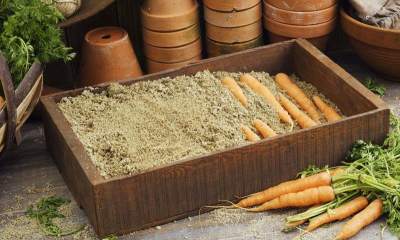 In sand... A layer of sand (no more than 5-6 cm) is poured onto the bottom of a wooden box or plastic box. Lay a layer of carrots on top (the roots do not touch each other). Cover the vegetables with a layer of sand.
In sand... A layer of sand (no more than 5-6 cm) is poured onto the bottom of a wooden box or plastic box. Lay a layer of carrots on top (the roots do not touch each other). Cover the vegetables with a layer of sand.- In onion or garlic skins... As with sand, you can sprinkle carrots with onion (garlic) peels.
Phytoncides contained in garlic and onion peelings actively fight bacteria, fungi, and mold spores.
- In plastic bags... The sorted vegetables are placed in a bag and stored open in the cellar.
- In clay... Each carrot is individually dipped in clay diluted to the state of liquid sour cream. After the vegetables must be thoroughly dried and stored in a wooden box or cardboard box.
- Coniferous sawdust... The sorted carrots are placed in a box or on a shelf covered with coniferous sawdust. The top of the vegetables is also covered with coniferous wood shavings. Phenolic substances of spruces, pines or firs perfectly prevent the development of decay processes.
Advice
It is important to follow these simple tips:
 If the time of harvest has not yet come, and forecasters predict early frosts, agrofibre will help preserve root crops.
If the time of harvest has not yet come, and forecasters predict early frosts, agrofibre will help preserve root crops.- When the diameter of early carrots reaches 1 cm, the root vegetable is ready to be dug up.
- Early varieties are not suitable for long-term storage.
- Do not store carrots with tops. Greens very quickly suck moisture from the root crop, which will reduce the duration of its storage, make it tasteless, dry.
- If the air temperature in the cellar is below + 4 ° C, it is better to sprinkle the carrots with wet sand. If the temperature is above + 4 ° С, dry.
Related videos
When to store carrots, video tips:
Conclusion
By adhering to clear recommendations on when and how to harvest carrots, you can enjoy the taste and nutrients of this root vegetable for as long as possible.



